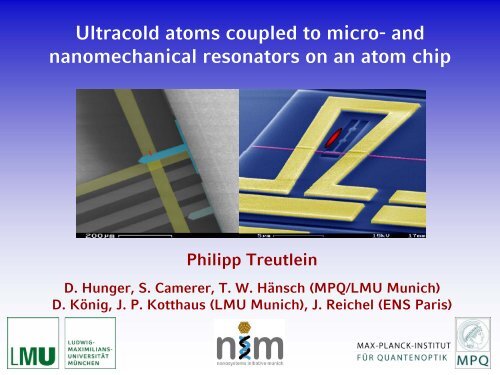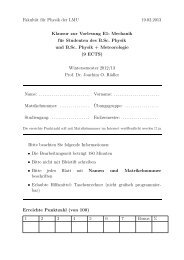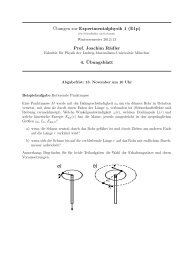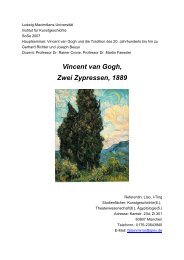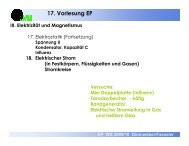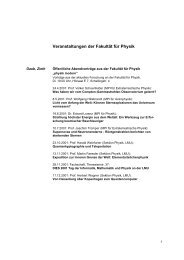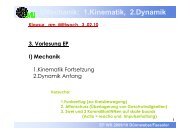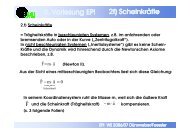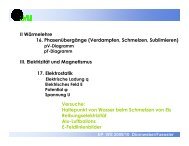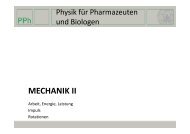and nanomechanical resonators on an atom chip
and nanomechanical resonators on an atom chip
and nanomechanical resonators on an atom chip
You also want an ePaper? Increase the reach of your titles
YUMPU automatically turns print PDFs into web optimized ePapers that Google loves.
Ultracold <strong>atom</strong>s coupled to micro- <str<strong>on</strong>g><strong>an</strong>d</str<strong>on</strong>g><br />
<str<strong>on</strong>g>n<strong>an</strong>omech<strong>an</strong>ical</str<strong>on</strong>g> <str<strong>on</strong>g>res<strong>on</strong>ators</str<strong>on</strong>g> <strong>on</strong> <strong>an</strong> <strong>atom</strong> <strong>chip</strong><br />
Philipp Treutlein<br />
D. Hunger, S. Camerer, T. W. Hänsch (MPQ/LMU Munich)<br />
D. König, J. P. Kotthaus (LMU Munich), J. Reichel (ENS Paris)
Qu<strong>an</strong>tum optics meets c<strong>on</strong>densed matter<br />
Qu<strong>an</strong>tum optical systems + c<strong>on</strong>densed matter c<strong>on</strong>cepts:<br />
Ultracold <strong>atom</strong>s in optical lattices:<br />
“artificial c<strong>on</strong>densed matter system”
Qu<strong>an</strong>tum optics meets c<strong>on</strong>densed matter<br />
Qu<strong>an</strong>tum optical systems + c<strong>on</strong>densed matter c<strong>on</strong>cepts:<br />
Ultracold <strong>atom</strong>s in optical lattices:<br />
“artificial c<strong>on</strong>densed matter system”<br />
C<strong>on</strong>densed matter systems + qu<strong>an</strong>tum optical c<strong>on</strong>cepts:<br />
Superc<strong>on</strong>ducting circuits, qu<strong>an</strong>tum dots:<br />
“artificial <strong>atom</strong>s”<br />
Laser cooling of mech<strong>an</strong>ical oscillators
Qu<strong>an</strong>tum optics meets c<strong>on</strong>densed matter<br />
Qu<strong>an</strong>tum optical systems + c<strong>on</strong>densed matter c<strong>on</strong>cepts:<br />
Ultracold <strong>atom</strong>s in optical lattices:<br />
“artificial c<strong>on</strong>densed matter system”<br />
C<strong>on</strong>densed matter systems + qu<strong>an</strong>tum optical c<strong>on</strong>cepts:<br />
Superc<strong>on</strong>ducting circuits, qu<strong>an</strong>tum dots:<br />
“artificial <strong>atom</strong>s”<br />
Laser cooling of mech<strong>an</strong>ical oscillators<br />
Qu<strong>an</strong>tum optical systems + c<strong>on</strong>densed matter systems:<br />
Atom <strong>chip</strong>s provide <strong>an</strong> interface<br />
between ultracold <strong>atom</strong>s <str<strong>on</strong>g><strong>an</strong>d</str<strong>on</strong>g><br />
solid-state systems <strong>on</strong> a <strong>chip</strong>
Atom <strong>chip</strong>s: qu<strong>an</strong>tum gases meet the solid state<br />
<strong>atom</strong>ic Bose-Einstein<br />
c<strong>on</strong>densate (BEC)<br />
10 – 10 4 <strong>atom</strong>s<br />
T ~ 500 nK<br />
500 nm<br />
variable dist<strong>an</strong>ce<br />
100 nm – 100 μm<br />
gold wires for<br />
<strong>atom</strong> trapping<br />
n<strong>an</strong>odevice<br />
microfabricated <strong>chip</strong><br />
T = 300 K
Interacti<strong>on</strong>s between two very different systems<br />
Bose-Einstein<br />
c<strong>on</strong>densate<br />
Chip-based micro<str<strong>on</strong>g><strong>an</strong>d</str<strong>on</strong>g><br />
n<strong>an</strong>ostructures
Interacti<strong>on</strong>s between two very different systems<br />
Bose-Einstein<br />
c<strong>on</strong>densate<br />
Chip-based micro<str<strong>on</strong>g><strong>an</strong>d</str<strong>on</strong>g><br />
n<strong>an</strong>ostructures<br />
m<strong>an</strong>ipulate<br />
„Qu<strong>an</strong>tum laboratory for <strong>atom</strong>s <strong>on</strong> a micro<strong>chip</strong>“<br />
• simple path to BEC <str<strong>on</strong>g><strong>an</strong>d</str<strong>on</strong>g> Fermi degeneracy<br />
• compact clocks <str<strong>on</strong>g><strong>an</strong>d</str<strong>on</strong>g> interferometers<br />
• qu<strong>an</strong>tum gases in tailored potentials (double well, 1D, ...)<br />
• cavity QED <strong>on</strong> a <strong>chip</strong><br />
• qu<strong>an</strong>tum informati<strong>on</strong> processing<br />
• BEC ent<strong>an</strong>glement
Interacti<strong>on</strong>s between two very different systems<br />
Bose-Einstein<br />
c<strong>on</strong>densate<br />
Chip-based micro<str<strong>on</strong>g><strong>an</strong>d</str<strong>on</strong>g><br />
n<strong>an</strong>ostructures<br />
probe<br />
„Qu<strong>an</strong>tum AFM tip“<br />
• study <strong>atom</strong>-surface interacti<strong>on</strong>s<br />
• microscopy of magnetic, electric, or microwave fields<br />
• m<strong>on</strong>itor dynamics of <strong>on</strong>-<strong>chip</strong> mech<strong>an</strong>ical <str<strong>on</strong>g>res<strong>on</strong>ators</str<strong>on</strong>g>,<br />
n<strong>an</strong>omagnets, Josephs<strong>on</strong> juncti<strong>on</strong>s, ...
Interacti<strong>on</strong>s between two very different systems<br />
Bose-Einstein<br />
c<strong>on</strong>densate<br />
Chip-based micro<str<strong>on</strong>g><strong>an</strong>d</str<strong>on</strong>g><br />
n<strong>an</strong>ostructures<br />
str<strong>on</strong>g interacti<strong>on</strong>s<br />
„Hybrid (qu<strong>an</strong>tum) systems“<br />
• coherent exch<strong>an</strong>ge of qu<strong>an</strong>ta<br />
• laser-cooled <strong>atom</strong>s as a refrigerator (nK base temperature...)<br />
• hybrid measurement devices (magnetic field sensor,...)<br />
• hybrid qu<strong>an</strong>tum informati<strong>on</strong> processors<br />
• fundamental studies of ent<strong>an</strong>glement <str<strong>on</strong>g><strong>an</strong>d</str<strong>on</strong>g> decoherence
Outline<br />
Atom <strong>chip</strong>s<br />
• basic c<strong>on</strong>cepts<br />
• experimental setup<br />
• BEC preparati<strong>on</strong><br />
Ultracold <strong>atom</strong>s near the <strong>chip</strong> surface<br />
• <strong>atom</strong>-surface interacti<strong>on</strong>s<br />
• coherent m<strong>an</strong>ipulati<strong>on</strong> <str<strong>on</strong>g><strong>an</strong>d</str<strong>on</strong>g><br />
coherence lifetime<br />
BEC coupled to micro- <str<strong>on</strong>g><strong>an</strong>d</str<strong>on</strong>g><br />
<str<strong>on</strong>g>n<strong>an</strong>omech<strong>an</strong>ical</str<strong>on</strong>g> <str<strong>on</strong>g>res<strong>on</strong>ators</str<strong>on</strong>g><br />
• coupling via surface potential<br />
• magnetic coupling:<br />
a mech<strong>an</strong>ical cavity QED system
The wire trap<br />
<strong>atom</strong>s are trapped in<br />
B-field minimum<br />
magnetic field<br />
of currentcarrying<br />
wire<br />
homogeneous<br />
field<br />
trap (2D)<br />
wire<br />
Zeem<strong>an</strong> Hamilt<strong>on</strong>i<strong>an</strong>:<br />
Wire field:<br />
Wire field gradient:<br />
weak-field seeking state: g F<br />
m F<br />
> 0
Chip-based wire traps<br />
Microfabricated wire <strong>on</strong> a <strong>chip</strong>:<br />
2D <strong>atom</strong> guide<br />
Wire crossing: „dimple-trap“<br />
harm<strong>on</strong>ic c<strong>on</strong>finement in 3D<br />
B-field<br />
<strong>atom</strong>s<br />
Benefits of integrati<strong>on</strong> <strong>on</strong> <strong>chip</strong>:<br />
• small wires - high trap<br />
frequencies: up to 1 MHz<br />
• small <strong>atom</strong>-surface dist<strong>an</strong>ce:<br />
< 1 μm possible<br />
• complex, tailored potentials<br />
through microfabricati<strong>on</strong>
State of the art: multi-layer <strong>atom</strong> <strong>chip</strong>s<br />
70 μm<br />
5 cm<br />
Au (1 μm)<br />
Si <strong>chip</strong><br />
AlN carrier <strong>chip</strong><br />
polyimide (6 μm)<br />
Au (5 μm)<br />
epoxy<br />
Au (10 μm)
State of the art: multi-layer <strong>atom</strong> <strong>chip</strong>s<br />
70 μm<br />
5 cm<br />
Au (1 μm)<br />
Si <strong>chip</strong><br />
AlN carrier <strong>chip</strong><br />
polyimide (6 μm)<br />
Au (5 μm)<br />
epoxy<br />
Au (10 μm)
State of the art: multi-layer <strong>atom</strong> <strong>chip</strong>s<br />
70 μm<br />
5 cm<br />
20 μm
State of the art: multi-layer <strong>atom</strong> <strong>chip</strong>s<br />
70 μm<br />
5 cm<br />
We gratefully<br />
acknowledge the<br />
Kotthaus group at CeNS,<br />
LMU Munich for<br />
cle<strong>an</strong>room access<br />
20 μm
Compact glass cell vacuum chamber<br />
water cooling<br />
wire c<strong>on</strong>nectors<br />
copper block<br />
3.5 cm<br />
<strong>atom</strong> <strong>chip</strong> with<br />
mirror surface<br />
base pressure<br />
in glass cell:<br />
3 × 10 -10 mbar<br />
at T = 300 K<br />
(trap lifetime ∼ 5 s<br />
with dispenser <strong>on</strong>)<br />
Rb dispenser<br />
to i<strong>on</strong> pump
Producti<strong>on</strong> of Bose-Einstein c<strong>on</strong>densates<br />
multi-step<br />
sequence:<br />
• mirror-MOT<br />
• optical molasses<br />
•optical pumping<br />
• magnetic trap<br />
• tr<strong>an</strong>sport <strong>atom</strong>s<br />
• evaporative cooling<br />
to BEC<br />
d<br />
all inside the<br />
same glass cell<br />
experimental<br />
cycle: 10 s
Absorpti<strong>on</strong> imaging<br />
image shadow cast by<br />
<strong>atom</strong>s <strong>on</strong>to CCD camera<br />
detecti<strong>on</strong> beam<br />
lens<br />
CCD camera<br />
<strong>chip</strong> surface<br />
BEC<br />
d = 50 μm<br />
absorpti<strong>on</strong> image
Bose-Einstein c<strong>on</strong>densati<strong>on</strong> <strong>on</strong> <strong>an</strong> <strong>atom</strong> <strong>chip</strong><br />
absorpti<strong>on</strong> images<br />
of <strong>atom</strong>ic density<br />
T > Tc<br />
evaporative cooling<br />
BEC of<br />
10 4 <strong>atom</strong>s<br />
in |1,-1i<br />
thermal<br />
ensemble of<br />
bos<strong>on</strong>s<br />
T ≈ Tc<br />
T ¿ Tc<br />
Bose-Einstein<br />
c<strong>on</strong>densate
Outline<br />
Atom <strong>chip</strong>s<br />
• basic c<strong>on</strong>cepts<br />
• experimental setup<br />
• BEC preparati<strong>on</strong><br />
Ultracold <strong>atom</strong>s near the <strong>chip</strong> surface<br />
• <strong>atom</strong>-surface interacti<strong>on</strong>s<br />
• coherent m<strong>an</strong>ipulati<strong>on</strong> <str<strong>on</strong>g><strong>an</strong>d</str<strong>on</strong>g><br />
coherence lifetime<br />
BEC coupled to micro- <str<strong>on</strong>g><strong>an</strong>d</str<strong>on</strong>g><br />
<str<strong>on</strong>g>n<strong>an</strong>omech<strong>an</strong>ical</str<strong>on</strong>g> <str<strong>on</strong>g>res<strong>on</strong>ators</str<strong>on</strong>g><br />
• coupling via surface potential<br />
• magnetic coupling:<br />
a mech<strong>an</strong>ical cavity QED system
Ultracold <strong>atom</strong>s close to a “hot“ surface<br />
Loss, heating <str<strong>on</strong>g><strong>an</strong>d</str<strong>on</strong>g> decoherence
Atom-surface interacti<strong>on</strong>s<br />
Previously unexplored area of <strong>atom</strong>-surface physics<br />
Theory: C. Henkel et al., 1999-2003<br />
Experiments: L<strong>on</strong>d<strong>on</strong>, Boulder, St<strong>an</strong>ford, MPQ/LMU<br />
1. Thermal magnetic near-field noise<br />
magnetic dipole<br />
moment of <strong>atom</strong><br />
fluctuating magnetic fields<br />
due to thermal moti<strong>on</strong> of<br />
electr<strong>on</strong>s in <strong>chip</strong> c<strong>on</strong>ductors<br />
Spin flips (loss) + decoherence
Atom-surface interacti<strong>on</strong>s<br />
Previously unexplored area of <strong>atom</strong>-surface physics<br />
Theory: C. Henkel et al., 1999-2003<br />
Experiments: L<strong>on</strong>d<strong>on</strong>, Boulder, St<strong>an</strong>ford, MPQ/LMU<br />
1. Thermal magnetic near-field noise<br />
magnetic dipole<br />
moment of <strong>atom</strong><br />
fluctuating magnetic fields<br />
due to thermal moti<strong>on</strong> of<br />
electr<strong>on</strong>s in <strong>chip</strong> c<strong>on</strong>ductors<br />
Spin flips (loss) + decoherence<br />
2. Attractive surface potential<br />
• v<strong>an</strong> der Waals/Casimir-Polder potential<br />
• Potential due to surface adsorbates<br />
electric polarizability<br />
of <strong>atom</strong><br />
(fluctuating) electric<br />
dipoles in surface<br />
potential<br />
V m<br />
V m<br />
+V s<br />
Loss due to reduced trap depth<br />
dist<strong>an</strong>ce to <strong>chip</strong> surface
Coherence close to the surface<br />
Hyperfine sublevels of 87 Rb with<br />
identical magnetic moments<br />
P. Treutlein et al., Phys. Rev. Lett. 92, 203005 (2004).<br />
rf<br />
|1〉 = |F=2,m F<br />
=+1〉<br />
F = 2<br />
mw<br />
|0〉 = |F=1,m F<br />
=-1〉<br />
F = 1<br />
m F<br />
= -2 -1 0 1 2<br />
“Qubit states“ of 87 Rb<br />
• both magnetically trappable<br />
• nearly identical potentials<br />
• l<strong>on</strong>g coherence lifetime
Coherence close to the surface<br />
P. Treutlein et al., Phys. Rev. Lett. 92, 203005 (2004).<br />
Hyperfine sublevels of 87 Rb with<br />
identical magnetic moments<br />
Coherence lifetime measurement<br />
(Ramsey sequence, <strong>atom</strong>-surface dist<strong>an</strong>ce: 9 μm)<br />
rf<br />
|1〉 = |F=2,m F<br />
=+1〉<br />
F = 2<br />
mw<br />
|0〉 = |F=1,m F<br />
=-1〉<br />
F = 1<br />
m F<br />
= -2 -1 0 1 2<br />
“Qubit states“ of 87 Rb<br />
• both magnetically trappable<br />
• nearly identical potentials<br />
• l<strong>on</strong>g coherence lifetime
Coherence close to the surface<br />
P. Treutlein et al., Phys. Rev. Lett. 92, 203005 (2004).<br />
Hyperfine sublevels of 87 Rb with<br />
identical magnetic moments<br />
Coherence lifetime measurement<br />
(Ramsey sequence, <strong>atom</strong>-surface dist<strong>an</strong>ce: 9 μm)<br />
rf<br />
|1〉 = |F=2,m F<br />
=+1〉<br />
F = 2<br />
mw<br />
|0〉 = |F=1,m F<br />
=-1〉<br />
F = 1<br />
m F<br />
= -2 -1 0 1 2<br />
“Qubit states“ of 87 Rb<br />
• both magnetically trappable<br />
• nearly identical potentials<br />
• l<strong>on</strong>g coherence lifetime
Plenty of room for applicati<strong>on</strong>s<br />
•Atomic clock <strong>on</strong> a <strong>chip</strong><br />
P. Treutlein et al.,<br />
PRL 92, 203005 (2004).<br />
•Atom interferometer<br />
•On-<strong>chip</strong> qu<strong>an</strong>tum gates<br />
|1i<br />
|0i<br />
P. Treutlein et al.,<br />
PRA 94, 022312 (2006).<br />
P. Treutlein et al.,<br />
Fortschr. Phys. 54, 702 (2006).
Minimum <strong>atom</strong>-surface dist<strong>an</strong>ce<br />
Potential above Si surface<br />
ω t /2π = 1 kHz<br />
Casimir-Polder surface potential V s<br />
lowers trap depth to V b<br />
(d).<br />
Minimum <strong>atom</strong>-surface dist<strong>an</strong>ce d m<br />
depends <strong>on</strong> trap frequency ω t<br />
<str<strong>on</strong>g><strong>an</strong>d</str<strong>on</strong>g><br />
<strong>on</strong> tolerable minimum trap depth.
Outline<br />
Atom <strong>chip</strong>s<br />
• basic c<strong>on</strong>cepts<br />
• experimental setup<br />
• BEC preparati<strong>on</strong><br />
Ultracold <strong>atom</strong>s near the <strong>chip</strong> surface<br />
• <strong>atom</strong>-surface interacti<strong>on</strong>s<br />
• coherent m<strong>an</strong>ipulati<strong>on</strong> <str<strong>on</strong>g><strong>an</strong>d</str<strong>on</strong>g><br />
coherence lifetime<br />
BEC coupled to micro- <str<strong>on</strong>g><strong>an</strong>d</str<strong>on</strong>g><br />
<str<strong>on</strong>g>n<strong>an</strong>omech<strong>an</strong>ical</str<strong>on</strong>g> <str<strong>on</strong>g>res<strong>on</strong>ators</str<strong>on</strong>g><br />
• coupling via surface potential<br />
• magnetic coupling:<br />
a mech<strong>an</strong>ical cavity QED system
Micro- <str<strong>on</strong>g><strong>an</strong>d</str<strong>on</strong>g> <str<strong>on</strong>g>n<strong>an</strong>omech<strong>an</strong>ical</str<strong>on</strong>g> <str<strong>on</strong>g>res<strong>on</strong>ators</str<strong>on</strong>g><br />
Mech<strong>an</strong>ical c<strong>an</strong>tilever (Si, SiN, ...)<br />
Fundamental res<strong>on</strong><strong>an</strong>ce:<br />
t<br />
l<br />
w<br />
a(t)<br />
S. Camerer, LMU<br />
(collab. Hänsch/Kotthaus)
A gas of <strong>atom</strong>s as a refrigerator
A gas of <strong>atom</strong>s as a refrigerator<br />
laser-cooled <strong>atom</strong>s<br />
„base temperature“ < 1 μK<br />
⇒ cool the res<strong>on</strong>ator to the ground state
A gas of <strong>atom</strong>s as a refrigerator<br />
laser-cooled <strong>atom</strong>s<br />
„base temperature“ < 1 μK<br />
⇒ cool the res<strong>on</strong>ator to the ground state<br />
Yes, if ...<br />
... str<strong>on</strong>gly coupled<br />
... to a single mode<br />
... of a small res<strong>on</strong>ator<br />
... with low damping
Proposals for hybrid qu<strong>an</strong>tum systems<br />
Theoretical proposals involving <strong>atom</strong>s/i<strong>on</strong>s/molecules<br />
<str<strong>on</strong>g><strong>an</strong>d</str<strong>on</strong>g> mech<strong>an</strong>ical <str<strong>on</strong>g>res<strong>on</strong>ators</str<strong>on</strong>g><br />
paper system coupling<br />
D. J. Winel<str<strong>on</strong>g><strong>an</strong>d</str<strong>on</strong>g> et al., J. Res. NIST 103, 259 (1998). i<strong>on</strong> electrostatic<br />
L. Ti<strong>an</strong> et al., PRL 92, 247902 (2004). i<strong>on</strong> electrostatic<br />
W. K. Hensinger et al., PRA 72, 041405 (2005). i<strong>on</strong> electrostatic<br />
D. Meiser et al., PRA 73, 033417 (2006). <strong>atom</strong>s optical<br />
P. Treutlein et al., PRL 99, 140403 (2007). <strong>atom</strong>s magnetic<br />
C. Genes et al., arXiv:0801.2266 (2008). <strong>atom</strong>s optical<br />
H. I<strong>an</strong> et al, arXiv:0803.0776 (2008). <strong>atom</strong>s optical<br />
K. Hammerer et al., arXiv:0804.300 (2008). <strong>atom</strong>s optical<br />
S. Singh et al., arXiv:0805.3735 (2008). polar<br />
molecules<br />
electrostatic<br />
X. X. Yi et al., arXiv:0807.2703 (2008). <strong>atom</strong> optical<br />
...
Coupling mech<strong>an</strong>isms<br />
coupling via surface potential<br />
coupling via optical lattice<br />
magnetic coupling
First experiment: commercial AFM c<strong>an</strong>tilever<br />
SiN c<strong>an</strong>tilever:<br />
L = 200 μm,<br />
W = 40 μm,<br />
T = 600 nm<br />
Au+Cr mirror,<br />
thickness 65 nm<br />
res<strong>on</strong><strong>an</strong>ce frequency:<br />
ω r<br />
/2π = 10.0 kHz<br />
quality factor:<br />
Q = 1600<br />
200 μm
Calibrati<strong>on</strong> of c<strong>an</strong>tilever amplitude<br />
Beam deflecti<strong>on</strong> readout:<br />
- laser focused <strong>on</strong> c<strong>an</strong>tilever tip<br />
- driven c<strong>an</strong>tilever<br />
(20mVpp)<br />
- thermal c<strong>an</strong>tilever<br />
- beam deflecti<strong>on</strong> detected with<br />
quadr<strong>an</strong>t photodiode<br />
- signal recovered with two ch<strong>an</strong>nel<br />
Lockin amplifier<br />
res<strong>on</strong><strong>an</strong>ce parameters<br />
res<strong>on</strong><strong>an</strong>ce frequency 10kHz<br />
Q factor 1655<br />
driving efficiency 31.1nm/V
Atom <strong>chip</strong> with AFM c<strong>an</strong>tilever<br />
MOT regi<strong>on</strong><br />
w/ dielectric mirror<br />
wire b<strong>on</strong>ds<br />
piezo for<br />
actuati<strong>on</strong><br />
spacer<br />
AFM c<strong>an</strong>tilever<br />
<strong>chip</strong><br />
base <strong>chip</strong><br />
experiment <strong>chip</strong>
Atom <strong>chip</strong> with AFM c<strong>an</strong>tilever
Magnetic trap close to c<strong>an</strong>tilever
Magnetic trap close to c<strong>an</strong>tilever<br />
c<strong>an</strong>tilever support<br />
c<strong>an</strong>tilever<br />
d=120 μm<br />
2 × 10 3 <strong>atom</strong>s
Atom preparati<strong>on</strong> close to c<strong>an</strong>tilever
Atom preparati<strong>on</strong> close to c<strong>an</strong>tilever<br />
d
Atom preparati<strong>on</strong> close to c<strong>an</strong>tilever<br />
d<br />
Casimir-Polder surface potential:<br />
decreases trap depth loss of <strong>atom</strong>s<br />
remaining fracti<strong>on</strong> of <strong>atom</strong>s:<br />
χ =<br />
1−<br />
exp( −U / k B<br />
T )<br />
sudden loss of Boltzm<strong>an</strong>n tail,<br />
see Lin et al., PRL 92, 050404 (2004).<br />
(hold time: 1 ms)<br />
U<br />
µ c
Coupling <strong>atom</strong>s to c<strong>an</strong>tilever moti<strong>on</strong>
Coupling <strong>atom</strong>s to c<strong>an</strong>tilever moti<strong>on</strong><br />
Oscillating c<strong>an</strong>tilever modulates:<br />
barrier height → <strong>atom</strong> loss<br />
trap positi<strong>on</strong> → drives c.o.m. oscillati<strong>on</strong><br />
trap frequency → heating
Detecti<strong>on</strong> of c<strong>an</strong>tilever res<strong>on</strong><strong>an</strong>ce with <strong>atom</strong>s<br />
<strong>atom</strong>s<br />
a<br />
piezo-driven c<strong>an</strong>tilever:<br />
oscillati<strong>on</strong> amplitude:<br />
res<strong>on</strong><strong>an</strong>ce frequency:<br />
a ~ 100 nm r.m.s.<br />
ω r /2π = 10.0 kHz<br />
6 Hz<br />
<strong>atom</strong> trap parameters:<br />
<strong>atom</strong>-surface dist<strong>an</strong>ce: d = 760 nm<br />
trap frequency: ω t /2π = 10.5 kHz<br />
thermal ensemble T = 1.4 T c
Dependence of signal <strong>on</strong> <strong>atom</strong>-surface dist<strong>an</strong>ce<br />
• drive c<strong>an</strong>tilever <strong>on</strong> res<strong>on</strong><strong>an</strong>ce<br />
• sc<strong>an</strong> <strong>atom</strong>-surface dist<strong>an</strong>ce<br />
c<strong>on</strong>trast<br />
SNR<br />
a=62nm
Parametric res<strong>on</strong><strong>an</strong>ce<br />
• Fixed piezo driving strength <str<strong>on</strong>g><strong>an</strong>d</str<strong>on</strong>g> frequency<br />
• Piezo drive set <strong>on</strong> c<strong>an</strong>tilever res<strong>on</strong><strong>an</strong>ce (a = 80 nm)<br />
• Sc<strong>an</strong> trap frequency<br />
frequency of<br />
c<strong>an</strong>tilever<br />
c<strong>an</strong>tilever drives<br />
tr<strong>an</strong>siti<strong>on</strong>s between<br />
trap states
Trap spectroscopy with the c<strong>an</strong>tilever<br />
c<strong>an</strong>tilever drives<br />
tr<strong>an</strong>siti<strong>on</strong>s between<br />
trap states
Coupling via Casimir-Polder potential<br />
Summary:<br />
• <strong>atom</strong>-surface dist<strong>an</strong>ce < 1 μm required<br />
• parametric res<strong>on</strong><strong>an</strong>ce is the domin<strong>an</strong>t<br />
coupling mech<strong>an</strong>ism<br />
• coupling depends sensitively <strong>on</strong> trap<br />
parameters → c<strong>on</strong>trol<br />
Future experiments:<br />
• coupling to carb<strong>on</strong> n<strong>an</strong>otubes
Coupling mech<strong>an</strong>isms<br />
coupling via surface potential<br />
coupling via optical lattice<br />
magnetic coupling
Coupling via optical lattice
Coupling via optical lattice<br />
Optical lattice provides coupling<br />
over l<strong>on</strong>g dist<strong>an</strong>ces!
Coupling via optical lattice<br />
• l<strong>on</strong>g-dist<strong>an</strong>ce coupling<br />
• <strong>an</strong>harm<strong>on</strong>icity of lattice<br />
isolates two-level system<br />
• detect <strong>atom</strong>ic state via<br />
shape of wave functi<strong>on</strong><br />
Spielm<strong>an</strong> et.al.: PRA 73 (2006)
Coupling mech<strong>an</strong>isms<br />
coupling via surface potential<br />
coupling via optical lattice<br />
magnetic coupling<br />
P. Treutlein et al., PRL 99, 140403 (2007).<br />
related work: J. Kitching (NIST),<br />
PRL 97, 227602 (2006).
N<strong>an</strong>omech<strong>an</strong>ical res<strong>on</strong>ator with a magnetic tip<br />
Si<br />
Si c<strong>an</strong>tilever fabricated <strong>on</strong> SOI <strong>chip</strong><br />
Co<br />
l = 5 - 15 μm<br />
w = 200 nm<br />
t = 100 nm<br />
ω r<br />
/2π ∼ 1 MHz<br />
m eff<br />
∼ 10 -16 kg<br />
Q ∼ 10 3 –10 5<br />
Co ferromagnet (single magnetic domain)<br />
• n<strong>an</strong>ometer-sized magnet (single domain)<br />
• magnetizati<strong>on</strong> al<strong>on</strong>g l<strong>on</strong>g axis<br />
(form <strong>an</strong>isotropy)<br />
• dipole field with str<strong>on</strong>g gradient<br />
B<br />
y<br />
AFM<br />
S<br />
m<br />
N<br />
MFM
Magnetic coupling mech<strong>an</strong>ism<br />
P. Treutlein et al., PRL 99, 140403 (2007).<br />
BEC trapped close<br />
to res<strong>on</strong>ator tip<br />
Res<strong>on</strong>ator oscillati<strong>on</strong>s<br />
Si<br />
(<strong>atom</strong>ic spin)<br />
oscillating B-field<br />
couples to <strong>atom</strong>ic spin<br />
Co<br />
F = 2<br />
oscillating field due to c<strong>an</strong>tilever moti<strong>on</strong>:<br />
coupling Hamilt<strong>on</strong>i<strong>an</strong>:<br />
where<br />
F = 1<br />
m F<br />
= -2 -1 0 1 2
Chip layout <str<strong>on</strong>g><strong>an</strong>d</str<strong>on</strong>g> trapping potential<br />
simulati<strong>on</strong> of potential<br />
(includes magnetic potential, gravity, <str<strong>on</strong>g><strong>an</strong>d</str<strong>on</strong>g><br />
Casimir-Polder surface potential)<br />
coupling:<br />
but: static magnetic field gradient of<br />
Co magnet distorts the trap<br />
(trap frequency c<strong>an</strong>not be increased<br />
because of collisi<strong>on</strong>al loss)<br />
w<strong>an</strong>t large G m<br />
compensati<strong>on</strong> magnets to<br />
reduce static field<br />
(oscillatory field unaffected)
A mech<strong>an</strong>ical cavity QED system<br />
Tavis-Cummings model:<br />
N <strong>atom</strong>s<br />
coupling<br />
single res<strong>on</strong>ator mode<br />
|S,m S<br />
=S><br />
a+ a<br />
|S,m S<br />
=-S><br />
S + S - P. Treutlein et al., PRL 99, 140403 (2007).<br />
...<br />
n = 2<br />
n = 1<br />
n = 0<br />
• Atoms (BEC) treated as collective spin S, hS z i = (N 1 -N 0 )/2 (both states trapped)
A mech<strong>an</strong>ical cavity QED system<br />
Tavis-Cummings model:<br />
P. Treutlein et al., PRL 99, 140403 (2007).<br />
N <strong>atom</strong>s<br />
coupling<br />
single res<strong>on</strong>ator mode<br />
|S,m S<br />
=S><br />
|S,m S<br />
=-S><br />
S + S -<br />
a+<br />
a<br />
...<br />
n = 2<br />
n = 1<br />
n = 0<br />
• Atoms (BEC) treated as collective spin S, hS z i = (N 1 -N 0 )/2 (both states trapped)<br />
• cavity QED parameters: g coupling strength<br />
κ = ω r /2Q res<strong>on</strong>ator damping rate (assume Q=10 5 )<br />
γ <strong>atom</strong> loss rate (surface, three body collisi<strong>on</strong>s, ...)<br />
coupling to single <strong>atom</strong>:<br />
coupling to BEC (N=10 4 ):<br />
(g, κ, γ) = 2π × (62, 14, 0.3) Hz, 250 kHz trap frequency<br />
(gN 1/2 , κ, γ) = 2π × (20, 5, 10) Hz, 3 kHz trap frequency<br />
(limited by collisi<strong>on</strong>al loss)
Cooling the c<strong>an</strong>tilever with the <strong>atom</strong>s<br />
N À hni th<br />
|S| = N/2 ~ 10 4 T = 50 mK: hni th ∼ 10 3<br />
p(n)<br />
S<br />
hni th<br />
n<br />
p(n)<br />
(π-pulse)<br />
S<br />
hni < hni th<br />
n<br />
more possibilities:<br />
•c<strong>an</strong>tilever readout<br />
• driving the c<strong>an</strong>tilever with <strong>atom</strong>s<br />
• tr<strong>an</strong>sfer of n<strong>on</strong>classical states of the <strong>atom</strong>s to the c<strong>an</strong>tilever
Outlook: <strong>chip</strong> prototype<br />
Atom <strong>chip</strong> prototype<br />
BEC<br />
Co n<strong>an</strong>omagnet<br />
Si c<strong>an</strong>tilever<br />
gold wires for BEC trapping<br />
fabricati<strong>on</strong> challenges:<br />
• fabricate magnets <strong>on</strong> free-st<str<strong>on</strong>g><strong>an</strong>d</str<strong>on</strong>g>ing<br />
mech<strong>an</strong>ical structures<br />
• m<strong>an</strong>y steps of electr<strong>on</strong> beam lithography
Group members<br />
www.munich<strong>atom</strong><strong>chip</strong>.de<br />
Philipp<br />
Treutlein<br />
Pascal<br />
Böhi<br />
David<br />
Hunger<br />
Joh<strong>an</strong>nes<br />
Hoffrogge<br />
Max<br />
Riedel<br />
Steph<strong>an</strong><br />
Camerer<br />
D<strong>an</strong>iel König<br />
(Kotthaus group)<br />
T. W. Hänsch group MPQ <str<strong>on</strong>g><strong>an</strong>d</str<strong>on</strong>g> LMU Munich<br />
Collaborati<strong>on</strong>s:<br />
D. König <str<strong>on</strong>g><strong>an</strong>d</str<strong>on</strong>g> J. Kotthaus (CeNS, LMU Munich),<br />
J. Reichel (LKB, ENS Paris), M. Wallquist <str<strong>on</strong>g><strong>an</strong>d</str<strong>on</strong>g> P. Zoller (Innsbruck)


